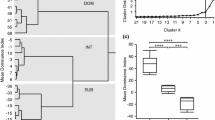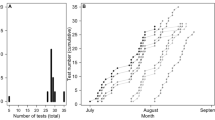Abstract
Precopulatory sexual cannibalism (predation of a potential mate prior to copulation) offers an extreme example of intersexual conflict, a current focus in behavioral ecology. The ‘aggressive-spillover’ hypothesis, posits that precopulatory sexual cannibalism may be a nonadaptive by-product of a general syndrome of voracity (aggression towards prey) that is expressed in multiple behavioral contexts. In this view, selection favoring high levels of voracity throughout ontogeny spills over to cause sexual cannibalism in adult females even when it is not necessarily beneficial. Using the North American fishing spider, Dolomedes triton, we present the first in depth test of this hypothesis. We found support for three aspects of the spillover hypothesis. First, voracity towards hetero-specific prey results in high feeding rates, large adult size, and increased fecundity. Second, juvenile and adult voracity are positively correlated (i.e., voracity is a consistent trait over ontogeny). Third, voracity towards hetero-specific prey is indeed positively correlated with precopulatory sexual cannibalism. Assays of antipredator behavior further revealed positive correlations between boldness towards predators, voracity and precopulatory sexual cannibalism. Overall, our results support the notion that precopulatory sexual cannibalism in D. triton is part of a behavioral syndrome spanning at least three major contexts: foraging, predator avoidance, and mating.
Similar content being viewed by others
References
Andrade MCB (1996) Sexual selection for male sacrifice in the Australian redback spider. Science 271:70–72
Arnqvist G (1992) Courtship behavior and sexual cannibalism in the semiaquatic fishing spider, Dolomedes-fimbriatus (Clerck) (Araneae, Pisauridae). J Arachnol 20:222–226
Arnqvist G, Henriksson S (1997) Sexual cannibalism in the fishing spider and a model for the evolution of sexual cannibalism based on genetic constraints. Evol Ecol 11:255–273
Bakker TCM (1986) Aggressiveness in sticklebacks (Gasterosteus aculeatus): a behaviour-genetic study. Behaviour 98:1–144
Barth FG (1982) Spiders and vibratory signals: sensory reception and behavioral significance. In: Witt PN, Rovner JS (eds) Spider communication: mechanisms and ecological significance. Princeton University Press, Princeton, pp 67–122
Bell AM, Stamps JA (2005) The development of behavioural differences between individuals and populations of stickleback (Gasterosteus aculeatus). Anim Behav 68(6):1339–1348
Bishop SC (1924) A revision of the Pisauridae of the United States. Bull NY Mus 252:1–140
Bleckmann H, Barth FG (1984) Sensory ecology of a semi-aquatic spider (Dolomedes triton). II. The release of predatory behaviour by water surface waves. Behav Ecol Sociobiol 14:303–312
Bleckmann H, Lotz T (1987) The vertebrate-catching behavior of the fishing spider Dolomedes triton (Araneae, Pisauridae). Anim Behav 35:641–651
Carico JE (1973) The nearctic species of the genus Dolomedes (Araneae: Pisauridae). Bull Mus Comp Zool 144:435–488
Choe JC, Crespi BJ (1997) The evolution of mating systems in insects and arachnids. Cambridge University Press, Cambridge
Crowley PH, Travers SE, Linton MC, Cohn SL, Sih A, Sargent RC (1991) Mate density, predation risk, and the seasonal sequence of mate choices: a dynamic game. Am Nat 137:567–596
Dingle H (2001) The evolution of migratory syndromes in insects. In: Woiod IP, Reynolds DR, Thomas CD (eds) Insect movement: mechanisms and consequences. Proceedings of the Royal Entomological Society’s 20th Symposium. CABI Publishers, New York, pp 159–181
Elgar MA (1992) Sexual cannibalism in spiders and other invertebrates. In: Elgar MA, Crespi BJ (eds) Cannibalism: ecology and evolution among diverse taxa. Oxford University Press, Oxford, pp 128–155
Elgar MA, Nash DR (1988) Sexual cannibalism in the garden spider Araneus diadematus. Anim Behav 36:1511–1517
Elgar MA, Schneider JM, Herberstein ME (2000) Female control of paternity in the sexually cannibalistic spider Argiope keyserlingi. Proc R Soc Lond 267:2439–2443
Elgar MA, Schneider JM (2004) The evolutionary significance of sexual cannibalism. Adv Study Behav 34:135–164
Fahey BF, Elgar MA (1997) Sexual cohabitation as mate-guarding in the leaf-curling spider Phonognatha graeffei Keyserling (Araneoidea, Araneae). Behav Ecol Sociobiol 40:127–133
Huntingford FA (1976) The relationship between anti-predator behaviour and aggression among con-specifics in the three-spined stickleback. Anim Behav 24:245–260
Jackson RR, Pollard SD (1997) Jumping spider mating strategies: sex among cannibals in and out of webs. In: Choe JC, Crespi BJ (eds) The evolution of mating systems in insects and arachnids. Cambridge University Press, Cambridge, pp 340–351
Jakob EM, Marshall SD, Uetz GW (1996). Estimating fitness: A comparison of body condition indices. Oikos 77(1):61–67
Johns PM, Maxwell MR (1997) Sexual cannibalism: who benefits? Trends Ecol Evol 12:127–128
Johnson JC (2001) Sexual cannibalism and fecundity selection in fishing spiders (Dolomedes triton): an evaluation of two explanations for female aggression towards potential mates. Anim Behav 61(5):905–914
Johnson JC (2005a) Cohabitation of juvenile females with mature males promotes sexual cannibalism in fishing spiders. Behav Ecol 16(1):269–273
Johnson JC (2005b) The role of body size in mating interactions of the sexually cannibalistic fishing spider Dolomedes triton. Ethology 111(1):51–61
Ketterson ED, Nolan V Jr (1999) Adaptation, exaptation and constraint: a hormonal perspective. Am Nat Suppl 154:4–25
Kreiter N, Wise D (2001) Prey availability limits fecundity and influences the movement pattern of female fishing spiders. Oecologia 127(3):417–424
Lima SL (1998) Stress and decision making under the risk of predation: Recent developments from behavioral, reproductive, and ecological perspectives. Stress Behav 27:215–290
Maupin JL, Riechert SE (2001) Superfluous killing in spiders: a consequence of adaptation to food-limited environments. Behav Ecol 12:569–576
Newman JA, Elgar MA (1991) Sexual Cannibalism in Orb-Weaving Spiders – an Economic-Model. Am Nat 138:1372–1395
Real L, Caraco T (1986) Risk and foraging in stochastic environments. Annu Rev Ecol Syst 17:371–390
Riechert SE, Hedrick AV (1993) A test for correlations among fitness-linked behavioural traits in the spider Agelenopsis aperta (Araneae: Agelenidae). Anim Behav 46:669–675
Riechert SE, Maynard-Smith J (1989) Genetic analyses of two behavioural traits linked to individual fitness in the desert spider Agelenopsis aperta. Anim Behav 37:624–637
Rowe L, Arnqvist A, Sih A, Krupa JJ (1994) Sexual conflict and the evolutionary ecology of mating patterns: water striders as a model system. Trends Ecol Evol 9:289–293
Roff DA (1992) The evolution of life histories: theory and analysis. Chapman and Hall, London
Sakaluk SK (1990) Sexual selection and predation: balancing reproductive and survival needs. In: Evans DL, Schmidt JO (eds) Insect defenses. Suny Press, Albany, pp 63–90
Schneider JM, Elgar MA (2002) Sexual cannibalism in Nephila plumipes as a consequence of female life history strategies. J Evol Biol 15:84–91
Sih A (1994) Predation risk and the evolutionary ecology of reproductive behavior. J Fish Biol 45:111–130
Sih A, Lauer M, Krupa JJ (2002) Path analysis and the relative importance of male female conflict, female choice and male-male competition in water striders. Anim Behav 63:1079–1089
Sih A, Kats LB, Maurer EF (2003) Behavioral correlations across situations and the evolution of antipredator behavior in a sunfish-salamander system. Anim Behav 65:29–44
Sih A, Bell A, Johnson JC, Ziemba R (2004a) Behavioral syndromes: an integrative overview. Quart Rev Biol 79(3):241–277
Sih A, Bell A, Johnson JC (2004b) Behavioral syndromes: an ecological and evolutionary overview. Trends Ecol Evol 19(7):372–378
Spence JR, Zimmerman M, Wojcicki JP (1996) Effects of food limitation and sexual cannibalism on reproductive output of the fishing spider Dolomedes triton (Araneae: Pisauridae). Oikos 75:373–382
Wilson DS, Coleman K, Clark AB, Biederman L (1993) The shy-bold continuum in pumpkinseed sunfish (Lepomis gibbosus): an ecological study of a psychological trait. J Comp Psychol 107:250–260
Zimmerman M, Spence JR (1989) Prey use of the fishing spider Dolomedes triton: An important predator of the neuston community. Oecologia 80:187–194
Zimmerman M, Spence JR (1992) Adult population dynamics and reproductive effort of the fishing spider Dolomedes triton (Araneae, Pisauridae) in central Alberta. Can J Zool 70:2224–2233
Acknowledgements
We thank Erich Marks and Gina Hupton for assistance with data collection and Patrick Crumrine for help in collecting the animals. Alison Bell commented on multiple versions of the manuscript. Financial assistance was provided by NSF-DDIG #0206237 to JCJ and NSF-IBN 0078033 and NSF-IBN 0222063 to AS. The experiment presented herein complies with all laws of the United States of America.
Author information
Authors and Affiliations
Corresponding author
Additional information
Communicated by M. Elgar
Rights and permissions
About this article
Cite this article
Johnson, J.C., Sih, A. Precopulatory sexual cannibalism in fishing spiders (Dolomedes triton): a role for behavioral syndromes. Behav Ecol Sociobiol 58, 390–396 (2005). https://doi.org/10.1007/s00265-005-0943-5
Received:
Revised:
Accepted:
Published:
Issue Date:
DOI: https://doi.org/10.1007/s00265-005-0943-5




